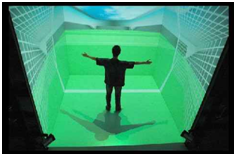New Citations | VR Muscle Training, Hypertension, & Stem Cell Smile Reconstruction
 Virtual Reality Muscle Training in Stroke Patients: Muscle weakening of the lower extremities has a significant correlation with loss of balance and walking ability in stroke patients. Researchers at Sehan University studied the effect of a virtual reality-based eccentric training program on lower extremity muscle activation and balance for rehabilitation of stroke patients. BIOPAC’s EMG100C surface electromyography (EMG) system was used to measure the activation of the lower extremity muscles. Read the full paper on the Effect of VR-based training on Muscle Activation in Stroke Patients here.
Virtual Reality Muscle Training in Stroke Patients: Muscle weakening of the lower extremities has a significant correlation with loss of balance and walking ability in stroke patients. Researchers at Sehan University studied the effect of a virtual reality-based eccentric training program on lower extremity muscle activation and balance for rehabilitation of stroke patients. BIOPAC’s EMG100C surface electromyography (EMG) system was used to measure the activation of the lower extremity muscles. Read the full paper on the Effect of VR-based training on Muscle Activation in Stroke Patients here.
Muscle Training Effects on Hypertension: Hypertension is a complex chronic condition characterized by elevated arterial blood pressure. Researchers from Universidade Federal do Rio Grande do Sul in Brazil recently performed a study testing the efficacy of inspiratory muscle training in reducing blood pressure in adults with hypertension. Noninvasive continuous blood pressure curves, heart rate, and electrocardiogram tracings were simultaneously recorded using BIOPAC’s MP150 data acquisition system. Read the full paper on the Effect of Inspiratory Muscle Training on High Blood Pressure from Hypertension here.
Stem Cell Use for Smile Reconstruction in Facial Paralysis Patients: Cross-face nerve grafting is used to reconstruct emotionally controlled smiling in people with completely irreversible facial paralysis. However, the efficacy of this procedure varies depending on the ability of the axons to regenerate. Doctors at Ahi Evran’s University tested the hypothesis that adipose-derived stem cells would enhance axonal regeneration and enhance recovery of the facial nerve function. BIOPAC’s MP36R system was used during the procedure to electrically evoke electromyograms. Read the full paper on Stem Cell Use in Cross-Facial Nerve Grafting here.
Stay Connected